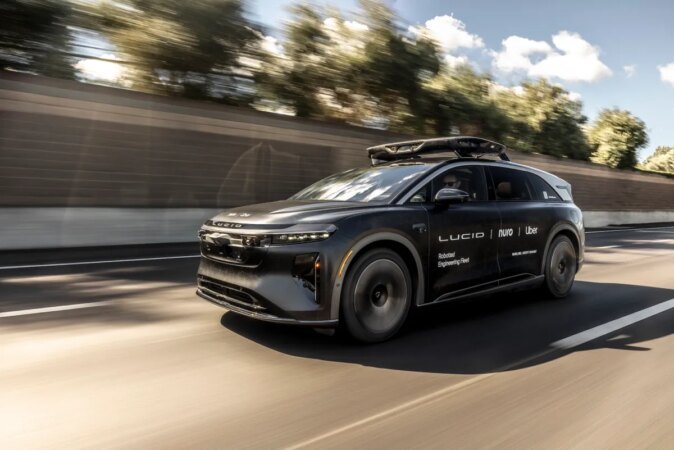Fast Facts
-
Launch of Premium Robotaxi Service: Uber will introduce a premium robotaxi service in San Francisco in 2026, using Lucid Motors’ Gravity SUVs with self-driving technology from Nuro, intensifying competition with Waymo.
-
Significant Investment: Uber plans to invest $300 million in Lucid and purchase at least 20,000 Gravity SUVs over six years to develop its autonomous ride-hailing service.
-
Testing and Validation: A test fleet of about 100 vehicles is in development, with Nuro integrating its self-driving system for on-road testing, simulation, and closed-course validation.
-
Expanding Partnerships: Over the past two years, Uber has established numerous partnerships in the autonomous vehicle space, further solidifying its position in the evolving ride-hailing and self-driving sectors.
Competition Ignites in San Francisco
Uber recently announced it will launch a premium robotaxi service in San Francisco using Lucid Motors’ electric Gravity SUVs. This new venture, set for 2026, intensifies competition with Waymo, which has long dominated the area with its established robotaxi service. The announcement came during the TechCrunch Disrupt 2025 event, drawing significant attention. Uber’s Chief Product Officer described the Bay Area as a fitting place for this innovation. This region has historically been a hub for transformative technology and innovation.
The partnership involves Nuro’s self-driving technology integrated into vehicles designed by Lucid. Uber also plans to invest $300 million in this collaboration, purchasing at least 20,000 SUVs over the next six years. Consequently, this expanded fleet will enhance their autonomous ride-hailing capabilities. While both companies previously clashed over trade secrets, they have since found common ground, partnering in other areas like Phoenix. Now, however, Uber’s targeted entry into San Francisco could reignite rivalries and shift market dynamics.
Paving the Way for Future Mobility
The launch of Uber’s robotaxi service raises questions about the practicality and acceptance of autonomous vehicles. Many consumers remain cautious about using driverless technology. However, Uber aims to address these concerns by emphasizing safety and reliability. Furthermore, the company has tested vehicles using both public roads and controlled environments to ensure a smooth rollout.
This venture could contribute significantly to the future of urban mobility. As cities become crowded, efficient transportation solutions will become vital. Premium robotaxis may offer a convenient alternative to traditional car ownership. Therefore, the widespread adoption of this technology could enhance the commuting experience for many people.
Uber’s initiative aligns with the growing trend of electric and autonomous vehicles that aim to reduce carbon emissions and traffic congestion. Partnering with companies like Nuro and Lucid demonstrates Uber’s commitment to enhancing its technological capabilities. Ultimately, as Uber and Waymo compete in this rapidly evolving landscape, consumers stand to benefit from improved services, more choices, and potentially lower costs in the near future.
Expand Your Tech Knowledge
Dive deeper into the world of Cryptocurrency and its impact on global finance.
Discover archived knowledge and digital history on the Internet Archive.
TechV1

